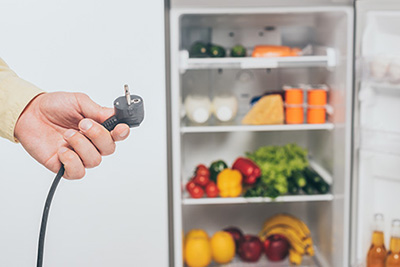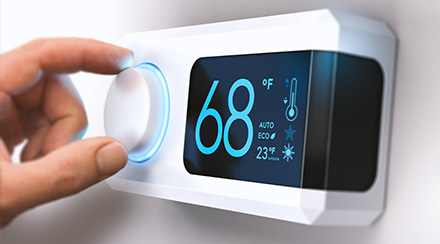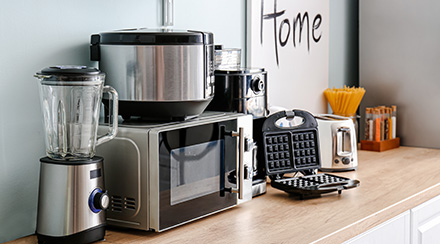How Many Watts Does a Refrigerator Use?

Is your refrigerator running? Before you go out and catch it, let’s take a moment to examine just how much power a refrigerator uses while it’s running all day long.
The refrigerator is one of the biggest energy-consuming appliances in the average home, according to the U.S. Energy Information Administration. Space heating typically consumes the most energy, followed by water heating, air conditioning and lighting, but refrigeration accounts for an average of between three and five percent of a home’s overall energy use.
The energy consumption of refrigerators can vary quite a bit from one model to the next, but one of the most significant factors in refrigerator energy efficiency is the age of the appliance. All refrigerators lose a little efficiency over time, and newer refrigerators are designed to operate much more efficiently than older models.
So what does this mean for your refrigerator, or for the next refrigerator you buy? Let’s take a look at how you can do your own calculations.
How Many Watts Does a Refrigerator Use?
The average refrigerator wattage for most residential refrigerator/freezer combos is between 300 and 800 watts of electricity, according to Energy Sage, an energy information portal funded by the Department of Energy. But the stated wattage of a refrigerator can be somewhat misleading, because refrigerators use different amounts of electricity depending on what they’re doing. When a refrigerator initially cycles on, it briefly uses a large surge of electricity – but once it cycles off to merely maintain the desired temperature, it uses much less. Energy Sage recommends dividing a refrigerator’s stated wattage by 3 to get an estimate of its “running wattage.”
So if you have a refrigerator with a stated wattage of 600 watts, its running wattage may be closer to 200 watts. To estimate how much it will cost to run this refrigerator, you must first convert the running wattage to kilowatts (1,000 watts):
200 W ÷ 1,000 W = .2 kW
Electricity is measured on your utility bill in kilowatt hours (kWh), which is a measurement of wattage over time. The refrigerator in this example runs at .2 kW, which means running it for one hour will consume .2 kWh. To estimate how many kWh it will consume in one day, simply multiply this rate by 24:
.2 kWh x 24 hours = 4.8 kWh
And to estimate how many kWh it will consume in a year, multiply the daily rate by 365:
4.8 kWh x 365 days = 1752 kWh
These totals can then be multiplied by your electrical utility’s kWh rate to estimate the refrigerator’s running cost. Let’s say your electricity rate is 12 cents per kWh. The cost estimates for this refrigerator would be:
4.8 kWh x $0.12 = $0.576 per day
1752 kWh x $0.12 = $210.24 per year
You can perform these same calculations on freezers and mini fridges as well.
How many watts does a freezer use? Chest freezers that meet the high efficiency standards of the ENERGY STAR program consume about 215 kWh per year, and upright freezers that meet this standard consume around 395 kWh per year.
How much electricity does a mini fridge use? Compact refrigerators that meet the ENERGY STAR standards range from about 100 to 470 kWh per year.

Other Ways to Check Refrigerator Energy Use
Fortunately, there’s a shortcut to these calculations. Since 1980, the Federal Trade Commission has administered the EnergyGuide program to standardize appliance product information labels, making it easy to estimate energy usage and compare models. If you still have the manual and documentation that came with your current refrigerator, you may find the yellow and black EnergyGuide label among them. And if you don’t, you can search for it online using your refrigerator’s make and model number.
The EnergyGuide label will tell you the estimated annual electricity use of an appliance in kWh, as well as an estimated annual operating cost based on average kWh rates. You can perform a more accurate cost calculation by multiplying the estimated annual electricity use by the kWh rate you were charged on your latest electricity bill.
If you’re really curious about how much electricity your refrigerator is using, you can try using an electricity monitor. There are low-tech models that plug directly into the outlet your appliance is using, as well as high-tech smart systems that track energy information throughout your home. These devices can allow you to see and measure the fluctuations in energy consumption that occur as your refrigerator cycles on and off, and can give you a more accurate picture of energy use that accounts for your specific refrigerator’s efficiency loss over time.
Refrigerator Energy Efficiency Tips
Your refrigerator can be one of the biggest energy users in your home. So now that you know how to calculate energy use and cost estimates for your refrigerator, how can you keep those figures as low as possible? Here are a few of our best cost-saving tips for home refrigeration:
- Clean your refrigerator regularly. Inside the fridge, make sure all vents are clean and unobstructed. But it’s also important to clean the outside at least twice per year – taking special care to remove dust from the coils and vents. The coils are located on the bottom of most modern fridges, which makes them somewhat difficult to clean, but this can be done with a thin, long-handled appliance brush. On older refrigerators, the coils may be on the back.
- Set the thermostats responsibly. There’s no need for your refrigerator to be colder than 37 degrees Fahrenheit, or for your freezer to be colder than zero. Set your thermostats to maintain these temperatures.
- Locate your refrigerator away from heat sources. If your refrigerator is right next to your oven or a sunny window, it will have to use more energy to expel heat.
- Don’t put hot food in the refrigerator. Allow leftovers to cool before storing them so that they don’t put too much stress on your appliance.
- Keep the refrigerator and freezer full, but not too full. An empty fridge or freezer has to work harder than a full one. If you have lots of empty space, you can fill it with containers of water to help conserve energy. But if your refrigerator or freezer is too full, it can restrict airflow, which may result in uneven cooling and higher energy consumption.
- Check your seals. The rubber gaskets around your refrigerator and freezer doors help keep cold air in and warm air out. If these become torn, cracked or brittle, they should be replaced.
Looking for Something Specific?
Select a category to find resources for topics that interest you.
Select Category

Related Articles:

Tips for Improving Your AC and Furnace Efficiency
We share maintenance tips for your heater and AC, and home improvement tips to help you use those systems less.
Read Article
Tips for Saving on Energy in Your Home
If you’re looking to learn more about energy efficiency for home systems and appliances, we’re sharing our favorite energy-saving tips.
Read Article
What Uses the Most Electricity In a Home?
We break down what uses the most energy in your home to give you an understanding of where your energy usage goes and where energy-saving tactics can make the most impact.
Read ArticleMost Popular Articles

Energy Plans to Fit Your Lifestyle
NRG offers electricity and natural gas plans with perks like cash back, travel rewards and more, so you can find a plan that fits your home and family.
How Many Watts Does a Refrigerator Use?
Is your refrigerator running? Before you go out and catch it, let’s take a moment to examine just how much power a refrigerator uses while it’s running all day long.
The refrigerator is one of the biggest energy-consuming appliances in the average home, according to the U.S. Energy Information Administration. Space heating typically consumes the most energy, followed by water heating, air conditioning and lighting, but refrigeration accounts for an average of between three and five percent of a home’s overall energy use.
The energy consumption of refrigerators can vary quite a bit from one model to the next, but one of the most significant factors in refrigerator energy efficiency is the age of the appliance. All refrigerators lose a little efficiency over time, and newer refrigerators are designed to operate much more efficiently than older models.
So what does this mean for your refrigerator, or for the next refrigerator you buy? Let’s take a look at how you can do your own calculations.
How Many Watts Does a Refrigerator Use?
The average refrigerator wattage for most residential refrigerator/freezer combos is between 300 and 800 watts of electricity, according to Energy Sage, an energy information portal funded by the Department of Energy. But the stated wattage of a refrigerator can be somewhat misleading, because refrigerators use different amounts of electricity depending on what they’re doing. When a refrigerator initially cycles on, it briefly uses a large surge of electricity – but once it cycles off to merely maintain the desired temperature, it uses much less. Energy Sage recommends dividing a refrigerator’s stated wattage by 3 to get an estimate of its “running wattage.”
So if you have a refrigerator with a stated wattage of 600 watts, its running wattage may be closer to 200 watts. To estimate how much it will cost to run this refrigerator, you must first convert the running wattage to kilowatts (1,000 watts):
200 W ÷ 1,000 W = .2 kW
Electricity is measured on your utility bill in kilowatt hours (kWh), which is a measurement of wattage over time. The refrigerator in this example runs at .2 kW, which means running it for one hour will consume .2 kWh. To estimate how many kWh it will consume in one day, simply multiply this rate by 24:
.2 kWh x 24 hours = 4.8 kWh
And to estimate how many kWh it will consume in a year, multiply the daily rate by 365:
4.8 kWh x 365 days = 1752 kWh
These totals can then be multiplied by your electrical utility’s kWh rate to estimate the refrigerator’s running cost. Let’s say your electricity rate is 12 cents per kWh. The cost estimates for this refrigerator would be:
4.8 kWh x $0.12 = $0.576 per day
1752 kWh x $0.12 = $210.24 per year
You can perform these same calculations on freezers and mini fridges as well.
How many watts does a freezer use? Chest freezers that meet the high efficiency standards of the ENERGY STAR program consume about 215 kWh per year, and upright freezers that meet this standard consume around 395 kWh per year.
How much electricity does a mini fridge use? Compact refrigerators that meet the ENERGY STAR standards range from about 100 to 470 kWh per year.
Other Ways to Check Refrigerator Energy Use
Fortunately, there’s a shortcut to these calculations. Since 1980, the Federal Trade Commission has administered the EnergyGuide program to standardize appliance product information labels, making it easy to estimate energy usage and compare models. If you still have the manual and documentation that came with your current refrigerator, you may find the yellow and black EnergyGuide label among them. And if you don’t, you can search for it online using your refrigerator’s make and model number.
The EnergyGuide label will tell you the estimated annual electricity use of an appliance in kWh, as well as an estimated annual operating cost based on average kWh rates. You can perform a more accurate cost calculation by multiplying the estimated annual electricity use by the kWh rate you were charged on your latest electricity bill.
If you’re really curious about how much electricity your refrigerator is using, you can try using an electricity monitor. There are low-tech models that plug directly into the outlet your appliance is using, as well as high-tech smart systems that track energy information throughout your home. These devices can allow you to see and measure the fluctuations in energy consumption that occur as your refrigerator cycles on and off, and can give you a more accurate picture of energy use that accounts for your specific refrigerator’s efficiency loss over time.
Refrigerator Energy Efficiency Tips
Your refrigerator can be one of the biggest energy users in your home. So now that you know how to calculate energy use and cost estimates for your refrigerator, how can you keep those figures as low as possible? Here are a few of our best cost-saving tips for home refrigeration:
- Clean your refrigerator regularly. Inside the fridge, make sure all vents are clean and unobstructed. But it’s also important to clean the outside at least twice per year – taking special care to remove dust from the coils and vents. The coils are located on the bottom of most modern fridges, which makes them somewhat difficult to clean, but this can be done with a thin, long-handled appliance brush. On older refrigerators, the coils may be on the back.
- Set the thermostats responsibly. There’s no need for your refrigerator to be colder than 37 degrees Fahrenheit, or for your freezer to be colder than zero. Set your thermostats to maintain these temperatures.
- Locate your refrigerator away from heat sources. If your refrigerator is right next to your oven or a sunny window, it will have to use more energy to expel heat.
- Don’t put hot food in the refrigerator. Allow leftovers to cool before storing them so that they don’t put too much stress on your appliance.
- Keep the refrigerator and freezer full, but not too full. An empty fridge or freezer has to work harder than a full one. If you have lots of empty space, you can fill it with containers of water to help conserve energy. But if your refrigerator or freezer is too full, it can restrict airflow, which may result in uneven cooling and higher energy consumption.
- Check your seals. The rubber gaskets around your refrigerator and freezer doors help keep cold air in and warm air out. If these become torn, cracked or brittle, they should be replaced.
Looking for Something Specific?
Select a category to find resources for topics that interest you.
Select Category

Related Articles:

Tips for Improving Your AC and Furnace Efficiency
We share maintenance tips for your heater and AC, and home improvement tips to help you use those systems less.
Read Article
Tips for Saving on Energy in Your Home
If you’re looking to learn more about energy efficiency for home systems and appliances, we’re sharing our favorite energy-saving tips.
Read Article
What Uses the Most Electricity In a Home?
We break down what uses the most energy in your home to give you an understanding of where your energy usage goes and where energy-saving tactics can make the most impact.
Read ArticleMost Popular Articles

Energy Plans to Fit Your Lifestyle
NRG offers electricity and natural gas plans with perks like cash back, travel rewards and more, so you can find a plan that fits your home and family.







